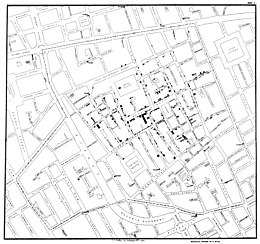
Back Cheografía humana AN جغرافيا بشرية Arabic মানৱ ভূগোল Assamese Xeografía humana AST मानव भूगोल AWA Сацыяльна-эканамічная геаграфія Byelorussian Сацыяльна-эканамічная геаграфія BE-X-OLD Социално-икономическа география Bulgarian मानव भूगोल Bihari মানবীয় ভূগোল Bengali/Bangla

Human geography or anthropogeography is the branch of geography which studies spatial relationships between human communities, cultures, economies, and their interactions with the environment, examples of which include urban sprawl and urban redevelopment.[1] It analyzes spatial interdependencies between social interactions and the environment through qualitative and quantitative methods.[2][3]This multidisciplinary approach draws from sociology, anthropology, economics, and environmental science, contributing to a comprehensive understanding of the intricate connections that shape lived spaces.[4]
- ^ Johnston, Ron (2000). "Human Geography". In Johnston, Ron; Gregory, Derek; Pratt, Geraldine; et al. (eds.). The Dictionary of Human Geography. Oxford: Blackwell. pp. 353–360.
- ^ Russel, Polly. "Human Geography". British Library. Retrieved 26 February 2017.
- ^ Reinhold, Dennie (7 February 2017). "Human Geography". www.geog.uni-heidelberg.de. Retrieved 23 February 2017.
- ^ Rubenstein, James M. (2020). Cultural Landscape, The: An Introduction to Human Geography (13th ed.). Pearson. ISBN 9780135729625.